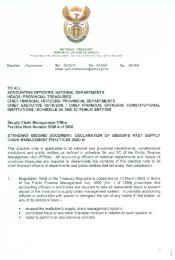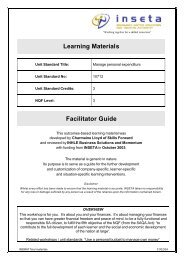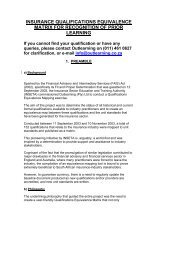SSP Brochure:Layout 1 - INSETA
SSP Brochure:Layout 1 - INSETA
SSP Brochure:Layout 1 - INSETA
You also want an ePaper? Increase the reach of your titles
YUMPU automatically turns print PDFs into web optimized ePapers that Google loves.
2 THE DEMAND FOR SKILLS IN THE SECTOR2.1 IntroductionThis chapter deals with the demand for skills in the insurance sector. First of all, the discussion of current employment provides informationon the types of skills utilised and the occupational categories in which people are employed in the sector.The chapter also deals with employment trends including changes in total employment, changes in the occupational structure of the sectorand changes in the skills required in the sector.The last part of the chapter focuses on future employment. In order to obtain a sense of the number of new employees that will be requiredover the planning period, a simple demand projection model was developed. Projections of future demand take into consideration growthin employment as well as replacement demand caused by retirement, mortality and people leaving the sector.2.2 Current employmentEmployment in the formal levy-paying component of the sector at the end of 2005 was estimated at 102 400. If the sector grew by 1.9%per year, employment in 2007 would be approximately 106 000. The occupational distribution of the sector is illustrated in Figure 2-1. Theoccupational category clerical and administrative workers is by far the largest with 40.6% of all employees falling in the category. Thiscategory is followed in size by professionals (26.9%), managers (13.2%) and sales workers 11.1%. 42Figure 2-1 Employment distribution according to occupational categorySource: Inseta, Survey of Employment, Scarce and Critical Skills, May 20062.21 ManagersTable 2-1 indicates the main managerial categories in the sector. The relatively high percentage (10.2%) of managing directors and ownerscan be ascribed to the large number of small firms in the sector. The insurance sector provides employment to various specialist managersincluding general insurance managers, sales and marketing managers and financial managers.Table 2.1 Occupational distribution of managers in the sectorOCCUPATIONSPercentage of all managersManagers: unspecified 14.8Managing directors and owners 10.2Specialist managers: sales and marketing 9.4Specialist managers: insurance general 8.4Specialist managers: finance 6.7Regional, district, area and provincial managers 5.3Specialist managers: human resources 4.142 The occupational distribution presented here differs markedly from that given in the 2005 version of the <strong>SSP</strong> mainly because the new occupational classification system (theorganising framework for organisations – OFO) was used which places employees in different main categories compared to the standard occupational classification (SOC)used in the previous <strong>SSP</strong>.<strong>INSETA</strong> Sector Skills Plan - page 15
















